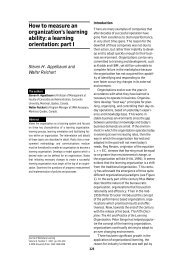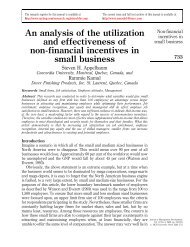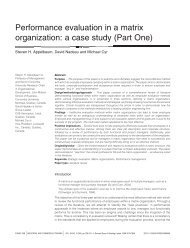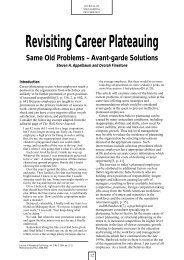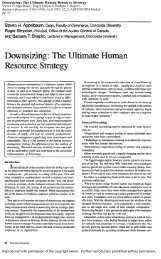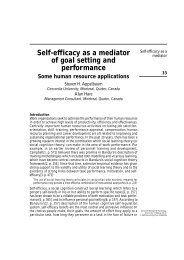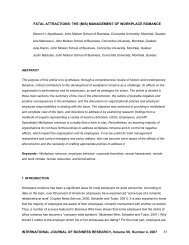Back to the future: revisiting Kotter's - Dr. Steven H. Appelbaum ...
Back to the future: revisiting Kotter's - Dr. Steven H. Appelbaum ...
Back to the future: revisiting Kotter's - Dr. Steven H. Appelbaum ...
Create successful ePaper yourself
Turn your PDF publications into a flip-book with our unique Google optimized e-Paper software.
JMD<br />
31,8<br />
772<br />
Obstacles created by supervisors and <strong>the</strong> hierarchical structure of organizations were<br />
also acknowledged by <strong>the</strong> organizational consultants at Burswood Resort Hotel in<br />
Western Australia who found that empowered actions and independent thinking were<br />
often were frowned upon by supervisors who were more used <strong>to</strong> <strong>the</strong> existing<br />
structured hierarchy (Cacioppe, 1998).<br />
Kotter (1996, pp. 107-9) stresses <strong>the</strong> pivotal role of training in <strong>the</strong> empowerment<br />
process and he has broad empirical support for this assertion. Den<strong>to</strong>n (1994) has<br />
described how Ford and its union, <strong>the</strong> United Au<strong>to</strong> Workers, jointly created an effective<br />
training programme that emphasized changing Ford’s corporate culture. He suggested<br />
that training was successful because it helped build a sense of responsibility and<br />
empowerment in <strong>the</strong> employees (Den<strong>to</strong>n, 1994). Likewise, a study on <strong>the</strong> influences of<br />
communication and training on third-party logistics providers found communication,<br />
training, and coaching <strong>to</strong> be <strong>the</strong> mechanisms through which companies develop<br />
empowered employees (Ellinger et al., 2010). Similar results have also been reported by<br />
Kappelman and Richards (1996).<br />
There is wide support for employee empowerment in change literature. A case<br />
study on organizational change at Honeywell Inc found that creating team ownership<br />
and a bot<strong>to</strong>m-up or empowered employee base is important <strong>to</strong> help an organization<br />
transform successfully (Paper et al., 2001). Similarly, results from research at a large<br />
telecommunication company have provided support for a positive relationship<br />
between participation and <strong>the</strong> successful implementation of strategic change (Lines,<br />
2007). In his PhD dissertation on understanding <strong>the</strong> approach of bringing <strong>the</strong> Toyota<br />
Production System’s lean concepts <strong>to</strong> a traditional operational model, Pinheiro (2010)<br />
concluded that “organizational change cannot occur without a paradigm shift in <strong>the</strong><br />
culture of <strong>the</strong> organization and <strong>the</strong> empowerment of workers at <strong>the</strong> functional frontline<br />
level”. Often, however, even giving employees a small empowering opportunity can<br />
have a profound effect on employee attitudes as this can provide <strong>the</strong>m with some sense<br />
of control over <strong>the</strong> change process and help move <strong>the</strong> change effort along (Kappelman<br />
et al., 1993). In essence, Step 5 still appears <strong>to</strong> be significant in 2011 as it was in 1996.<br />
Step 6: generate short-term wins<br />
Seeing <strong>the</strong> changes happening and working and recognizing <strong>the</strong> work being done by<br />
people <strong>to</strong>wards achieving <strong>the</strong> longer-term goals is critical in Kotter’s (1995) view.<br />
The former President of Lever Bro<strong>the</strong>rs’ Foods Division in <strong>the</strong> USA, Willie<br />
Pietersen, says that large-scale change can be a long, formidable undertaking, so it is<br />
important <strong>to</strong> create short-term wins (Pietersen, 2002). A number of early vic<strong>to</strong>ries, he<br />
insists, even if <strong>the</strong>y are small, create self-confidence and <strong>the</strong> belief that bigger successes<br />
are possible and this builds up <strong>the</strong> momentum <strong>to</strong>wards <strong>the</strong> longer-term goals<br />
(Pietersen, 2002). Rewarding opportunities and celebrating small wins also provide<br />
employees and management reassurance that <strong>the</strong>ir efforts are on <strong>the</strong> right track<br />
(Reichers et al., 1997; Marks, 2007). Note, however, that while focusing solely on<br />
short-term gains may increase <strong>the</strong> frequency of organizational change initiatives,<br />
finding <strong>the</strong> right balance between <strong>the</strong> short-term gains and <strong>the</strong> long-term effects of<br />
change on employee perception can become a complex issue for organizational leaders<br />
(Boga and Ensari, 2009).<br />
Short-term wins demonstrate that <strong>the</strong> change effort is paying off (Kotter, 1996,<br />
pp. 122-4). Such wins help <strong>the</strong> guiding coalition test <strong>the</strong> vision against real conditions<br />
and make adjustments (Kotter, 1996, pp. 122-4). Ford et al. (2008) found this “proof ”<br />
<strong>to</strong> be critical for <strong>the</strong> change management effort and stated that managers seeking <strong>to</strong>



